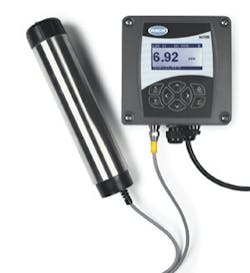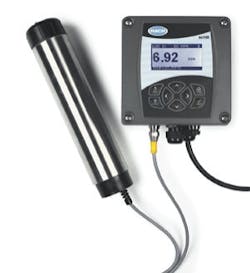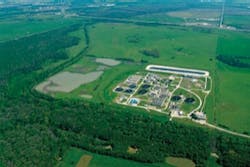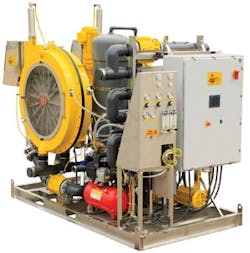By Bob Dabkowski
The key to optimizing the aeration process is accurate and reliable dissolved oxygen (DO) monitoring and control. To achieve this, the Duck Creek Wastewater Treatment Plant has adopted advanced luminescent technology for online DO monitoring.
Since going online in 1986, the Duck Creek Wastewater Treatment Plant in Garland, TX, faced an ongoing challenge in maintaining optimum dissolved oxygen (DO) levels in its trickling filter/solids contact system. While operators used periodic readings from handheld membrane-based DO probes to adjust aeration, consistently maintaining optimum DO remained elusive.
In 2005, when additional plant capacity was required, Garland added an activated sludge process, as opposed to expanding the existing trickling filter/solids contact system, and adopted new luminescent technology for online measurement and control of DO. The result has been greatly improved process accuracy and long-term reliability of instrumentation, reduced power and operational costs, and improved process efficiency.
System Overview
The City of Garland operates two biological wastewater treatment facilities–Rowlett Creek and Duck Creek–that serve a population of more than 300,000. The Duck Creek treatment facility, which receives wastewater from the city's west side as well as from the Town of Sunnyvale and from portions of the cities of Dallas and Richardson, is rated at 40 million gallons a day. The plant uses two parallel treatment trains–trickling filter/solids contact and activated sludge. Treated effluent is discharged into Duck Creek, which flows to the Trinity River. During dry months, the river may be composed of up to 95 percent wastewater; therefore, performance of the Duck Creek Plant is critical to the Trinity's health and usefulness as a drinking water source for those downstream.
Maintaining DO Levels
Although activated sludge systems are less expensive to build than trickling filter plants, they are typically more expensive to operate because of the need for greater energy to run blowers for aeration. The key to optimizing the aeration process is accurate and reliable DO control.
Insufficient levels of DO prevent the successful degradation of organic matter and create conditions for the proliferation of filamentous bacteria. Too high DO levels, on the other hand, wastes energy. Power costs related to the operation of activated sludge plants generally run from 30 percent to 60 percent of the total electrical power consumed, and the electricity bill is typically the first or second most costly operational expense at most facilities. Accurate DO control in the aeration process, however, can save plants substantial amounts of power–and money–by applying only enough air for the biological process to function efficiently.
Prior to the plant expansion, Duck Creek operators had used both handheld and permanent membrane-based DO probes, but were unhappy with their performance. The plant expansion led to the introduction of a different DO metering probe technology–the Hach Luminescent Dissolved Oxygen (LDO®) sensor. Unlike galvanic membrane sensors, that actually consume oxygen during a complicated measurement process, the LDO sensor relies on light transmission to determine DO levels. Also, the LDO probe requires no membrane or reagent.
The City of Garland, TX, operates the 40 mgd Duck Creek treatment facility, which receives wastewater from the city's west side as well as from portions of other nearby cities including Dallas. Treated effluent is discharged into Duck Creek, which flows to the Trinity River.
Fifteen LDO probes are installed at the Duck Creek plant – 12 in the activated sludge aeration basin and three in the older trickling filter/solids contact system. In the 20 mgd activated sludge system, the probes are mounted inside each of the basin's twelve 500,000-gallon cells. The probes are positioned on the end of swivel-mounted stanchions that place the sensors 18 to 24 inches below the water surface in each cell. In the plant's trickling filter/solids contact system, the probes are mounted in the system's three passes.
In three years of operation, the LDO sensors have proven their worth in terms of accuracy, reliability and improved plant performance. Through the SCADA system, operators systematically check probe readings and make adjustments as needed to the blower outputs. Although many wastewater treatment plants successfully use process LDO measurements to automatically adjust blowers based on current readings, operators at the Duck Creek plant prefer having "hands on" control to adjust the plant's five 300-hp and three 200-hp blowers.
Power Savings
The Duck Creek plant strives to maintain a DO level of 2-4 milligrams per liter (mg/l).
"We set a pressure set point," Clark said. "So, if we get a high level, we can bring the pressure down or take a blower off. We have the capability through our SCADA to adjust the air valve in each cell of the basin and adjust the set point on the blowers or start and stop blowers."
Fundamental to energy efficiency of any activated sludge process is the ability to vary the oxygen supplied to meet changes in flow and BOD loading. Clark said the accuracy of real-time DO monitoring allows the plant to often cycle off blowers to save energy.
"Eight times out of 10 we're running three blowers, while the remaining 20 percent of the time we're running two. Without the LDO probes in there, though, we would probably be running one additional blower most times, just to play it safe."
This reduction in blower usage translates into considerable power savings for the plant.
In the past, operators had checked all 12 aeration basin cells once a day using a handheld probe. Now, with the process DO probes installed, three cells are randomly checked with the handheld unit five days a week, as a backup procedure. The stationary LDO probe readings are consistently within 0.2 mg/L of the portable unit.
"It's a pretty harsh environment in the cells," Clark said, "but the LDO probes haven't caused us any problems. I was really surprised that something that's submerged in there has held up so well."
Fifteen LDO probes are installed at the Duck Creek plant – 12 in the activated sludge aeration basin and three in the plant's older trickling filter/solids contact system.
The LDO probe has a considerably longer life than that of traditional sensor technologies, partly because there are no membranes or electrolyte solutions that need replacement. Since the system is self-calibrating, time-consuming calibrations are not required. Nor are frequent cleanings. The system produces consistently accurate DO readings–even with organic buildup on the sensor.
"The only maintenance we do for the LDO probe is to periodically wipe the end of the sensor–just what's called for in the maintenance program," Clark said. "The only replacement part, an inexpensive sensor cap, should be replaced once a year, although we have gone a lot longer before needing to replace ours."
The probes plug into Hach sc100® controllers. At the Duck Creek plant, the controllers continuously read the probes and communicate via a 4-20 mA signal to the plant's SCADA System. Each controller has a built-in datalogger that collects measurements at user selectable intervals (1 to 15 minutes), along with calibration and verification points, alarm history, and instrument setup changes for up to six months. The controller is designed to receive data from up to two sensors simultaneously.
"After three years of continuous operation in both treatment trains, the probes are performing as well as the day they were installed," Clark said. "We have much tighter aeration control with the LDO probes, and with the alarms we have set up, we no longer have to adjust the blowers on the high side to be safe, which saves power and improves our overall process efficiency." WW
About the Author:Bob Dabkowski is a Wastewater Specialist for Hach Company and a Licensed Colorado Wastewater Operator. He is the author of several papers, articles, and application notes concerning wastewater treatment and has over eight years experience at Hach, advising process control & automation solutions. He may be contacted via email at [email protected].
More WaterWorld Current Issue Articles
More WaterWorld Archives Issue Articles






